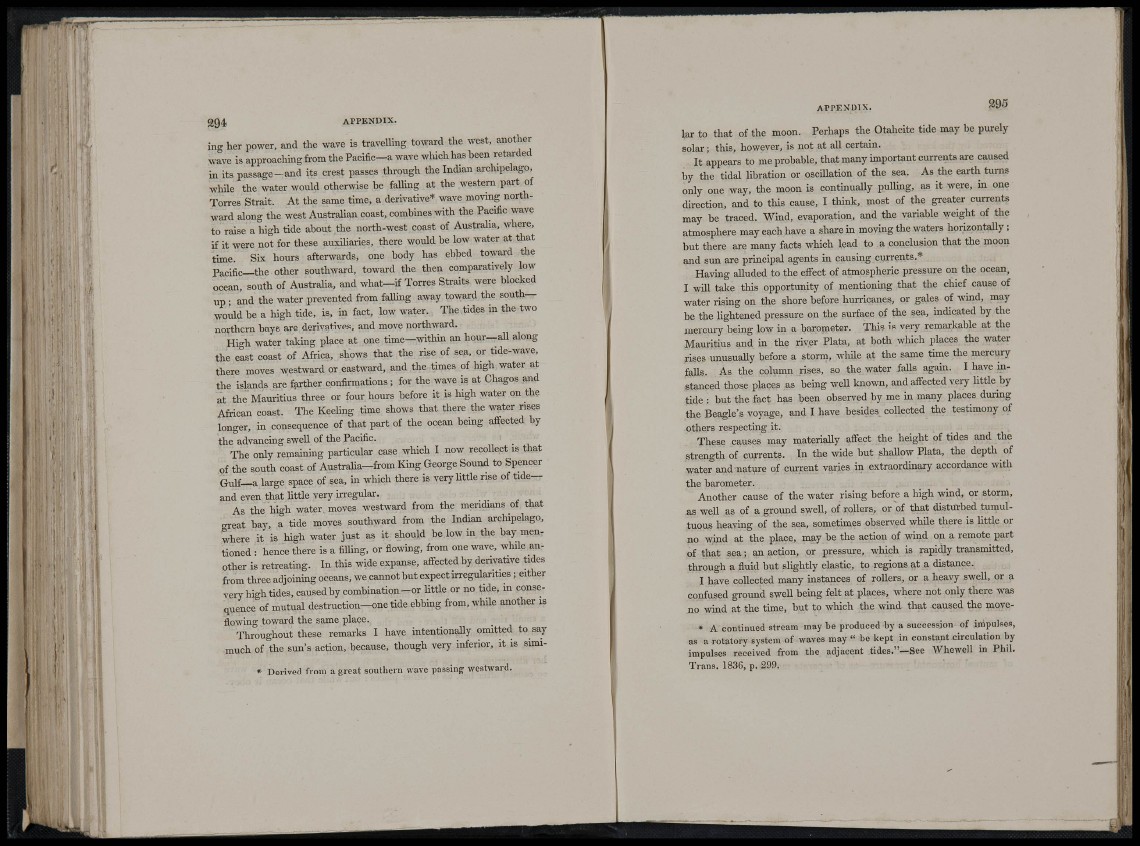
i t
ilf
f.f ;ii'Si'i lls
2 9 4 a p p e n d i x .
ing her power, and the wave is travelling toward the west, another
wave is approachingfrom the Pacific-a wave which has been retarded
in its passage-and its erest passes through the Indian archipelago,
while the water would otherwise be falling at the western part of
Torres Strait. At the same time, a derivative* wave movmg northward
along the west Australian coast, eombmes with the Pacific wave
to raise a high tide about the north-west coast of Australia, where,
if it were not for these arodharies, there would be low water at that
thne. Six hours afterwards, one body has ebbed toward the
Pacific—the other southward, toward the then comparatively low
ocean, south of AustraHa, and what-if Torres Straits were blocked
up • and the water prevented from faffing away toward the southwould
be a high tide, is, in fact, low water. The,tides in the two
northern bays are derivatives, and move northward.
High water taking place at one time—within an hour—aU along
the east coast of Africa, shows that the rise of sea, or tide-wave,
there moves westward or eastward, and the times of high water at
the islands are farther confirmations; for the wave is at Chagos and
at the Mauritius three or four hom-s before it is high water on the
African coast. The KeeUng time shows that there the water rises
longer, in consequence of that part of the ocean bemg afifected by
the advancmg swell of the Pacific.
The only remaining particular case which I now recollect is that
of the south coast of Australia-from King George Sound to Spencer
Gulf—a large space of sea, in which there is very httle rise of tide—
and even that little very hregular.
As the high water, moves westward from the meridians of that
great bay a tide moves southward from the Indian archipelago,
there it is high water just as it should be low in the bay mentioned
: hence there is a fiUing, or fiowmg, from one wave, while another
is rebreating. In this wide expanse, aifected by derivative tides
from three adjoining oceans, we cannot but expect irregularities; either
verj'high tides, caused by combination—or httle or no tide, m consequence
of mutual destruction—one tide ebbing from, while another is
fiowmg toward the same place.
Throughout these remarks I have intentionally omitted to say
much of the sun's action, because, though very inferior, it is simi-
• Derived from a great southern wave passing westward.
APPENDIX. 295
lar to that of the moon. Perhaps the Otalieite tide may be purely
solar; this, however, is not at all certain.
It appears to me probable, that many important currents are caused
by the tidal libration or oscillation of the sea. As the earth tiirns
only one way, the moon is continually pulling, as it were, in one
direction, and to this cause, I think, most of the greater currents
may be traced. Wind, evaporation, and the variable weight of the
atmosphere may each have a share in moving the waters horizontally ;
but there are many facts which lead to a conclusion that the moon
and sun are principal agents in causing currents.*
Having alluded to the efi'ect of atinospheric pressure on the ocean,
I will take this opportunity of mentionmg that the chief cause of
water rising on the shore before hurricanes, or gales of wind, may
be the lightened pressure on the surface of the sea, indicated by the
mercury being low in a barometer. This is very remarkable at the
Mauritius and m the river Plata, at both which places the water
rises unusuaUy before a storm, wlifle at the same time the mercury
faUs. As the column rises, so the water faUs again. I have instanced
those places as being well known, and affected very little by
tide : but the fact has been obsei-ved by me in many places during
the Beagle's voyage, and I have besides collected the testimony of
others respecting it.
These causes may materially affect the height of tides and the
sti-ength of currents. In the wide but shaflow Plata, the depth of
water and nature of current varies in extraordinary accordance with
the barometer.
Another cause of the water rising before a high wind, or storm,
as well as of a ground sweU, of rollers, or of that disturbed tumultuous
heaving of the sea, sometimes observed while there is little or
no -mnd at the place, may be the action of wind on a remote part
of that sea; an action, or pressure, which is rapidly transmitted,
through a fluid but slightly elastic, to regions at a distance.
I have collected many instances of rollers, or a heavy swell, or a
confused ground swell being felt at places, where not only there was
no wind at the time, but to which the wind that caused the move-
• A continued stream may be produced by a succession of impulses,
as a rotatory system of waves may " be kept in constant circulation by
impulses received f rom the adjacent t ide s . "—Se e Whewel l in Phi l .
Tr ans . 183C, p. 299.